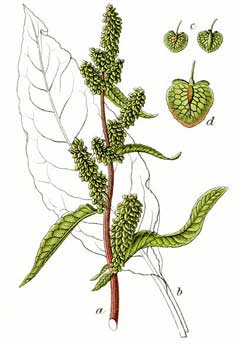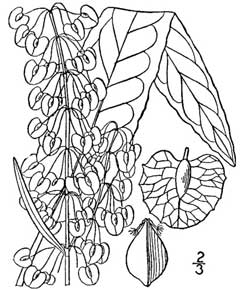 |
|
http://commons.wikimedia.org/wiki/File:Rumex_X_patientia_Sturm55.jpg |
 |
| Britton, N.L., and A. Brown. An illustrated flora of the northern United States, Canada and the British Possessions. Courtesy of Kentucky Native Plant Society. |
Translate this page:
Summary
The hybrid Rumex patientia x tianschanicus (Hybrid sorrel) is a good Carbon Farming plant. Rumex patientia x tianschanicus. Staple Crop: balanced carb and Industrial Crop: biomass.
Physical Characteristics

 Rumex_patientia is a PERENNIAL growing to 1.5 m (5ft) by 0.5 m (1ft 8in).
Rumex_patientia is a PERENNIAL growing to 1.5 m (5ft) by 0.5 m (1ft 8in).
See above for USDA hardiness. It is hardy to UK zone 6 and is not frost tender. It is in flower from June to July, and the seeds ripen in August. The species is hermaphrodite (has both male and female organs) and is pollinated by Wind.
It is noted for attracting wildlife.
Suitable for: light (sandy), medium (loamy) and heavy (clay) soils and can grow in heavy clay soil. Suitable pH: mildly acid, neutral and basic (mildly alkaline) soils. It can grow in semi-shade (light woodland) or no shade. It prefers moist soil.
UK Hardiness Map
US Hardiness Map
Synonyms
Plant Habitats
Edible Uses
Leaves - raw or cooked[1, 2, 5, 37, 177]. Eaten like spinach or made into a delicious puree, they are often mixed with a quarter part of sorrel in order to add flavour to them[183]. A fairly mild flavour[183], they make an excellent vegetable[K]. The leaves are produced very early in the year[27]. Carbon Farming - The hybrid Rumex patientia x tianschanicus is a good staple crop: balanced carb.
References More on Edible Uses
Medicinal Uses
Plants For A Future can not take any responsibility for any adverse effects from the use of plants. Always seek advice from a professional before using a plant medicinally.
The juice, and an infusion of the root, has been used as a poultice and salve in the treatment of various skin problems[257]. An infusion of the root has been used in the treatment of constipation[257]. The leaves have been rubbed in the mouth to treat sore throats[257].
References More on Medicinal Uses
The Bookshop: Edible Plant Books
Our Latest books on Perennial Plants For Food Forests and Permaculture Gardens in paperback or digital formats.

Edible Tropical Plants
Food Forest Plants for Hotter Conditions: 250+ Plants For Tropical Food Forests & Permaculture Gardens.
More

Edible Temperate Plants
Plants for Your Food Forest: 500 Plants for Temperate Food Forests & Permaculture Gardens.
More

More Books
PFAF have eight books available in paperback and digital formats. Browse the shop for more information.
Shop Now
Other Uses
Although no specific mention has been made for this species, dark green to brown and dark grey dyes can be obtained from the roots of many species in this genus, They do not need a mordant[168].
Special Uses
References More on Other Uses
Cultivation details
A very easily grown plant, it succeeds in most soils, preferring a moist moderately fertile well-drained soil in a sunny position[200]. Formerly cultivated for its edible leaves[1, 2, 37, 50], these can be available in early February if the winter is mild[K]. An important food plant for the caterpillars of many species of butterfly[30].The hybrid Rumex patientia x tianschanicus (Hybrid sorrel) is a good Carbon Farming plant. Rumex patientia x tianschanicus cultivation: new crop. Management: standard, coppice. Staple Crop: balanced carb. Industrial Crop: biomass.
References Carbon Farming Information and Carbon Sequestration Information
Temperature Converter
Type a value in the Celsius field to convert the value to Fahrenheit:
Fahrenheit:
The PFAF Bookshop
Plants For A Future have a number of books available in paperback and digital form. Book titles include Edible Plants, Edible Perennials, Edible Trees,Edible Shrubs, Woodland Gardening, and Temperate Food Forest Plants. Our new book is Food Forest Plants For Hotter Conditions (Tropical and Sub-Tropical).
Shop Now
Plant Propagation
Seed - sow spring in a cold frame. When they are large enough to handle, prick the seedlings out into individual pots and plant them out in the summer. Division in spring.
Other Names
If available other names are mentioned here
Native Range
TEMPERATE ASIA: Afghanistan, Iran, Syria, Turkey, Russian Federation-Ciscaucasia (Ciscaucasia), Armenia, Azerbaijan, Georgia, Russian Federation (Dagestan), Russian Federation (Altay), Kazakhstan, Kyrgyzstan, Tajikistan, Mongolia, Russian Federation (Habarovskij kraj, Primorye, Sakhalin), China (Heilongjiang Sheng, Henan Sheng, Hebei Sheng, Hunan Sheng, Hubei Sheng, Gansu Sheng, Jilin Sheng, Liaoning Sheng, Shanxi Sheng, Shandong Sheng, Shaanxi Sheng, Sichuan Sheng, Qinghai Sheng, Nei Mongol Zizhiqu, Ningxia Huizi Zizhiqu, Xinjiang Uygur Zizhiqu, Xizang Zizhiqu) TROPICAL ASIA: India (north), Nepal, Pakistan EUROPE: Austria, Czech Republic, Hungary, Slovakia, Russian Federation-European part (European part (south)), Ukraine (incl. Krym), Albania, Bulgaria, Bosnia and Herzegovina, Greece (north), Croatia, North Macedonia, Montenegro, Romania, Serbia, Slovenia
Weed Potential
Right plant wrong place. We are currently updating this section.
Please note that a plant may be invasive in one area but may not in your area so it's worth checking.
Conservation Status
IUCN Red List of Threatened Plants Status :

Growth: S = slow M = medium F = fast. Soil: L = light (sandy) M = medium H = heavy (clay). pH: A = acid N = neutral B = basic (alkaline). Shade: F = full shade S = semi-shade N = no shade. Moisture: D = dry M = Moist We = wet Wa = water.
Now available:
Food Forest Plants for Mediterranean Conditions
350+ Perennial Plants For Mediterranean and Drier Food Forests and Permaculture Gardens.
[Paperback and eBook]
This is the third in Plants For A Future's series of plant guides for food forests tailored to
specific climate zones. Following volumes on temperate and tropical ecosystems, this book focuses
on species suited to Mediterranean conditions—regions with hot, dry summers and cool, wet winters,
often facing the added challenge of climate change.
Read More
Expert comment
Author
L.
Botanical References
17200
Links / References
For a list of references used on this page please go here
Readers comment
| Add a comment |
|
If you have important information about this plant that may help other users please add a comment or link below. Only comments or links that are felt to be directly relevant to a plant will be included. If you think a comment/link or information contained on this page is inaccurate or misleading we would welcome your feedback at [email protected]. If you have questions about a plant please use the Forum on this website as we do not have the resources to answer questions ourselves.
* Please note: the comments by website users are not necessarily those held by PFAF and may give misleading or inaccurate information.
To leave a comment please Register or login here All comments need to be approved so will not appear immediately.
|
Subject : Rumex_patientia
|
|
|
|